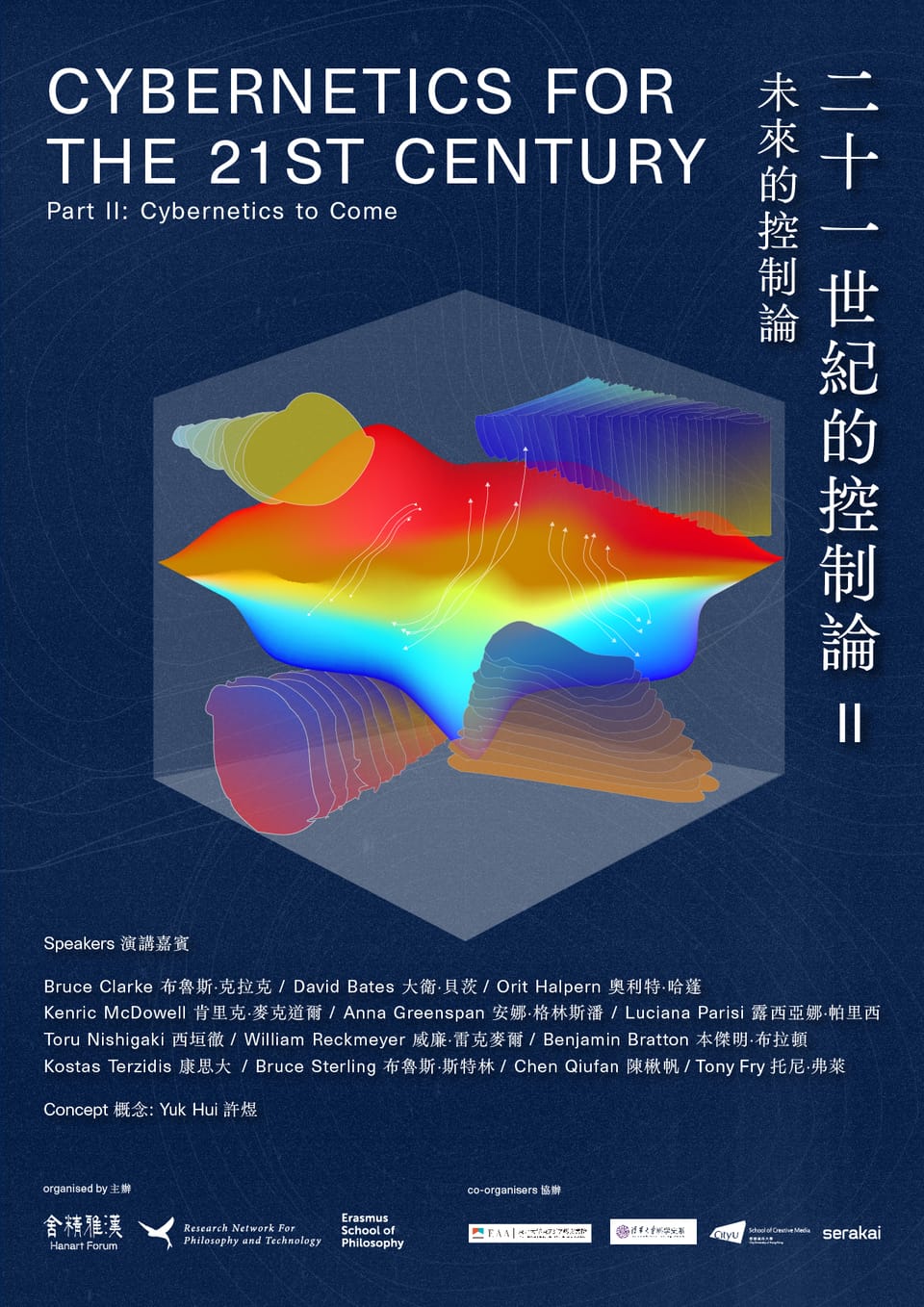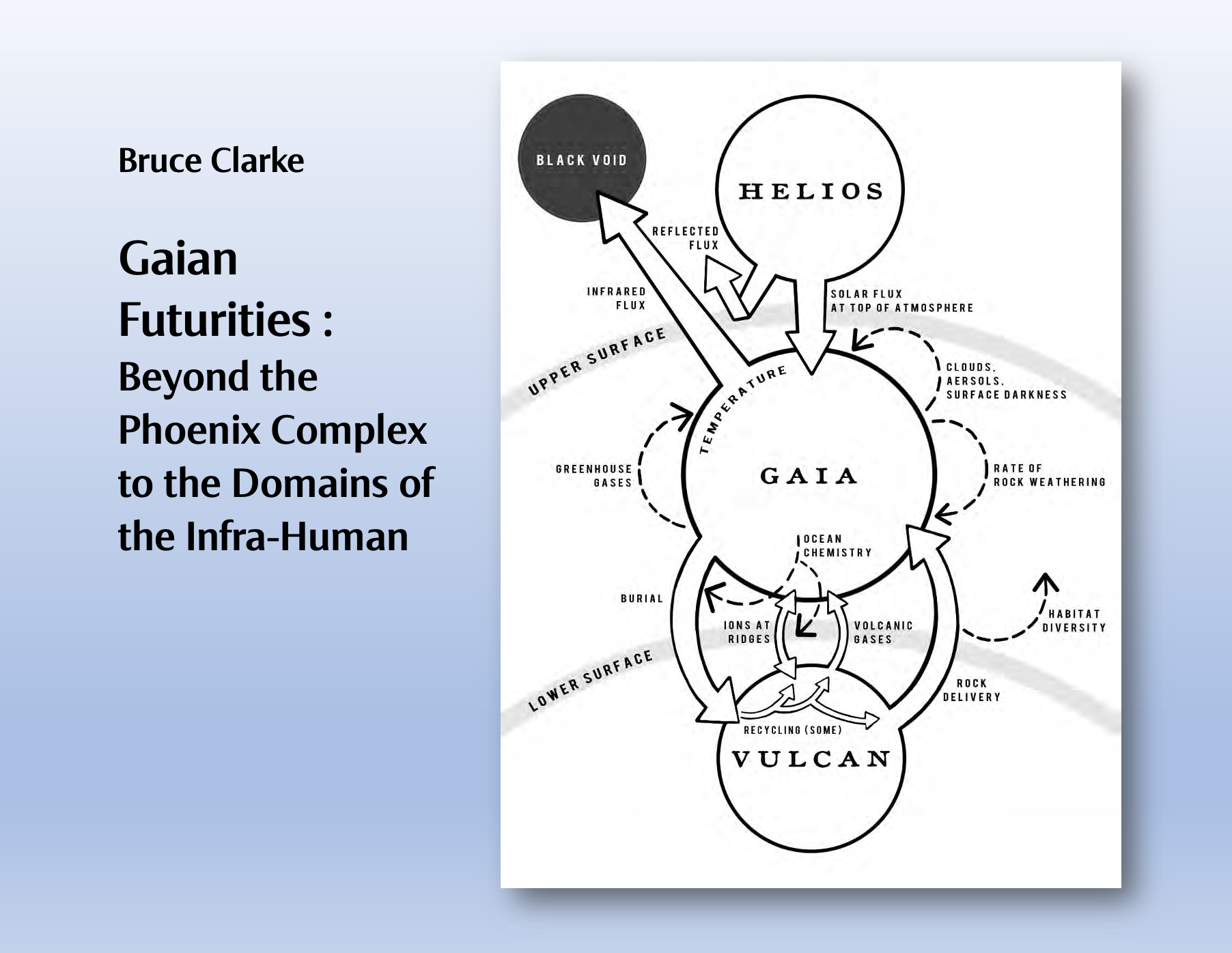Cybernetics for the 21st Century, Part II: Cybernetics to Come

Bruce Clarke
—from Hanart Forum's mission statement for the series, followed by the link to my presentation:
We are witnessing the “becoming organism” of machines, the technological planetarization and acceleration towards full automation. We are experiencing a post-metaphysical world filled with new possibilities of liberation and freedom enabled by automation, at the same time haunted by a nihilism marked by robot revolts, imminent wars and climate catastrophes. The second phase of the project is dedicated to “cybernetics to come,” that is to say, a future inspired by cybernetics, while at the same time, moving beyond the closed systems imposed by its models, as well as the apocalyptic imaginations such as the technological singularity, to reflect on the future of freedom, democracy, right, co-existence, aesthetics, etc. A thorough critique of cybernetics and a speculative philosophy of technology are necessary in order to explore the possible worlds to come.
Gaian Futurities: Beyond the Phoenix Complex to the Domains of the Infra-Human presentation by Dr. Bruce Clarke
My talk begins the series of presentations listed on the poster above. After placing the Gaia concept in the context of "Cybernetics to Come," I develop a reading of Gaian futurities as envisioned in the cybernetic writing practices of the second speaker K Allado-McDowell's Pharmako-AI and Air Age Blueprint.

—Recorded on December 22, 2023. Release date: April 23, 2024. Here is the text of the introduction:
For this talk, I have been asked to envision some form of future cybernetics, one that we may wish to hasten into existence by our own present speculations upon its virtual possibility. This hopeful cybernetics-to-come should counter or inoculate against systemic pathologies inducing unjust social regimentation, corporate exploitation, political violence, or environmental degradation. It should promote freedom and democracy, respect for natural rights and ontological diversity, and the pursuit of beauty, pleasure, and creativity. For assistance with this tall measure, I have implored the geobiosphere for wisdom regarding the foundations of our living world in a mode of natural technicity that has come to be called Gaia. Conceived as a system—or in an updated idiom, as a form of cosmotechnics—Gaia names the idea that living beings taken together with the worldmaking they perform as they evolve in relation to their solar and terrestrial environments have organized the planet so as to maintain its habitability over geological time. What then may this Gaia’s past and present states have to tell us about Gaian futurities for ecological and cultural flourishing?
A focus on Gaia embeds the cybernetic theme—as it were, organically, or geobiologically—within the requested meditation upon the future of the human technosphere. It connects this discussion to whatever expectations one may attach to the concept of Gaia, as that came forward in the later 20th century in the collaborative work of the British chemist James Lovelock and the American biologist Lynn Margulis. Beginning in the 1960s, Lovelock presented Gaia as a “biological cybernetic system.” Lovelock and Margulis originally conceived Gaia as a planetary system observing first-order cybernetic principles of homeostasis, negative feedback, and self-regulation. The second-order cybernetics formally codified by Heinz von Foerster in the 1970s and made concrete in Humberto Maturana and Francisco Varela’s concept of biological autopoiesis pressed the analysis of recursive processes beyond mechanical and computational control regimes toward natural systems’ operational autonomy and self-maintenance. At the end of the 1980s, Margulis and Lovelock reiterated the first-order biological cybernetics of the Gaia concept in relation to this second-order or autopoietic redescription, in terms of the biosphere’s contingent autonomy or operational self-reference: While “Cybernetic systems are ‘steered’” by some external agency, they wrote, “biological cybernetic systems are steered from the inside. . . . The Gaia hypothesis postulates a planet with the biota actively engaged in environmental regulation and control on its own behalf” (“Gaia and Geognosy” 9, 11).
Alongside Gaia’s more recent mainstreaming in the scientific academy as Earth system science, other precincts of academe have seen a continuing interest in the Gaia debate. A host of prominent thinkers in the critical and environmental social sciences and humanities, including Bruno Latour, Isabelle Stengers, Dipesh Chakrabarty, Donna Haraway, and Amitav Ghosh have addressed Gaia in a major key and specifically as a theme fit to challenge the destructive legacies of Western modernity. Déborah Danowski and Eduardo Viveiros de Castro put this trend well and succinctly in their critical anthropology of contemporary visions of apocalypse, The Ends of the World, which text builds to a chapter titled “Humans and Terrans in the Gaia War.” They write in their conclusion: “the name of Gaia is an anti-modernist provocation” (118). The implication here is that the unfolding of organic or Gaian cybernetics in particular has been covertly subversive of the reductionist and physicalist Modern scientific program that set it forth. Responding to Latour’s evocation of the Terrans—that is, the resistant multitudes who must outlive and so replace the modernist Humans who have wrought the worse degradations upon the Anthropocene biosphere, Danowski and Viveiros de Castro affirm that “What we still need to work out is who is the demos of Gaia, the people that this entity gathers and convokes, and who their enemy is” (90). In The Ends of the World, this idea of a “Gaia War” reflects our precarious present state. And in K Allado-McDowell’s Air Age Blueprint, a text I will turn to later in this talk, a shadowy character confronts the narrator with a related declaration: “In case you haven’t noticed, we are in a cybernetic war for the future of this planet” (133).
How then do we bring the Gaia War to an end, or at least, to a state of truce that allows for the non-warring co-existence of diverse living beings? When the Gaia War is over, what forms will future Terrans take, or, perhaps better, how will the future Terrans fit themselves to a Gaian technosphere into which AI affordances have been pervasively absorbed? Danowski and Viveiros de Castro largely sidestep the technological issue by evoking a slow society “rebecoming-indigenous” modelled on “Amerindian collectives” as a “‘figuration of the future,’ not a remnant of the past. Masters of techno-primitivist bricolage and politico-metaphysical metamorphosis, they are one of the possible chances, in fact, of a subsistence of the future” (122-23). Alternatively, Air Age Blueprint explicitly turns Viveiros de Castro’s anthropological insights otherwise, in the cybernetic direction of interspecies communication mediated by AI intercessors, bringing living “entities into communication, which reveals them to be subjects like us, in other words: secretly human. This secret humanity is the foundation of the Amerindian cosmology” (68). Viveiros de Castro has called this inner consistency across species Amerindian perspectivism; Allado-McDowell calls this cybernetic animism. I am calling it the infra-human. K's future vision binds biotic and metabiotic objects through a perspectivist construction of a Terran form of the posthuman, in which Gaia’s natural technicity as humanly redesigned and reinvented for the sake of a detoxified technosphere becomes the ground of a newly planetary indigeneity enfolding Gaia, the sum of the biota and its techniques.
K Allado-McDowell. Air Age Blueprint. Ignota, 2022
K Allado-McDowell. Pharmako-AI. Ignota, 2020.
Déborah Danowski and Eduardo Viveiros de Castro. The Ends of the World. Trans. Rodrigo Nunes. Malden, MA: Polity Press, 2017.
Gaia: Goddess of the Earth. NOVA documentary aired Tuesday, January 28, 1986.
Yuk Hui. Recursivity and Contingency. New York: Rowman and Littlefield, 2019.
Michael Marder. The Phoenix Complex: A Philosophy of Nature. Cambridge, MA: MIT Press, 2023.
Lynn Margulis. Symbiotic Planet: A New Look at Evolution. New York: Basic Books, 1998.
Lynn Margulis and James E. Lovelock. “Gaia and Geognosy.” In Global Ecology:Towards a Science of the Biosphere. Eds. M. B. Rambler, L. Margulis, and R. Fester. San Diego: Academic Press, 1989. 1-30.
Lynn Margulis and Dorion Sagan. Microcosmos: Four Billion Years of Evolution from Our Microbial Ancestors. New York: Summit Books, 1986.

Member discussion